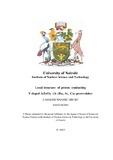| dc.description.abstract | Burning of fossil fuels has disastrous implications on the environment due to
emissions of nitrogen oxides, sulphur oxides and a wide range of toxic organic and
inorganic compounds. We are also about to deplete the available natural energy
sources and therefore research to find new, sustainable and clean energy sources are
crucial for the benefit of present and future generations. Hydrogen fuel cells provide
one such alternative and therefore research and development of fuel cells (Fuel cells,
2011) is important. The cells convert chemical energy directly into electrical energy
and have an advantage over conventional means of power generation due to their
high-energy conversion efficiency besides being environmentally friendly. The first
fuel cell was demonstrated over 160 years ago but development continued inhibited
by lack of attractive materials, which have high conductivity in the intermediate
temperature region of 200 to 500 ◦C.
This thesis is based on experimental studies carried out on perovskite structured
yttrium doped barium zirconate, calcium zirconate and strontium zirconate systems.
The main work included synthesis of yttrium doped barium zirconate with different
Y concentrations, followed by studying the local structure of the system as a function
of Y concentration and the influence of protons on the local structure surrounding the
Y ions. The experiments were performed using x-ray powder diffraction (XRD), to
study the average structure of the perovskite lattice, and infrared (IR) and
luminescence spectroscopy to study the local structure of the material.
The results indicated that increasing Y concentration leads to a slight, but clear,
distortion of the local structure of the perovskite and we also found a dependence on
hydration. Moreover, the results showed the symmetry around the Y atom was more
distorted in the dry sample than in the hydrated. For the 20% Y doped BaZrO3
sample in particular, spectral differences could not be resolved with the techniques
used, which would motivate a further study of the local ordering of the dopant atoms | en_US |

